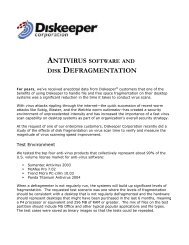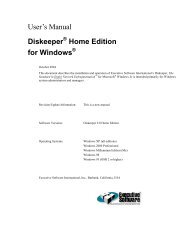Diskeeper 10 User's Manual
Diskeeper 10 User's Manual
Diskeeper 10 User's Manual
Create successful ePaper yourself
Turn your PDF publications into a flip-book with our unique Google optimized e-Paper software.
34 <strong>Diskeeper</strong> Operation<br />
You can also set exclusion times when the Smart Scheduling option will be prevented from scheduling a<br />
defragmentation run. When Smart Scheduling is selected, the Days drop-down option list will be limited to<br />
these times:<br />
Except Everyday<br />
Except Weekends<br />
Except Weekdays<br />
Except Monday<br />
Except Tuesday<br />
Except Wednesday<br />
Except Thursday<br />
Except Friday<br />
Except Saturday<br />
Except Sunday<br />
You can use the Start time: and End time: drop down lists to further define times when the scheduling of<br />
automatic defragmentation runs will not be allowed. For example, a schedule set like this:<br />
Type of Schedule<br />
Smart Scheduling<br />
Start Time<br />
Which Days<br />
Except Weekdays<br />
End Time<br />
1:00 am 3:00 am<br />
will allow <strong>Diskeeper</strong> to automatically determine how often to run, but will also prevent it from running between<br />
1:00 am and 3:00 am on weekdays (i.e., when your nightly backup is running).<br />
Screen Saver Mode<br />
When enabled, Screen Saver mode automatically starts defragmenting the selected volumes any time the screen<br />
saver starts on your computer. The defragmentation operation is paused whenever keyboard or mouse activity<br />
is detected on the computer. This option is available under the Schedule type: drop-down list in Job Schedule<br />
page of the Primary Defragmentation Job Properties dialog.<br />
If you only have a single volume selected for Screen Saver mode, the defragmentation operation is re-started at<br />
the logical “beginning” of the volume each time the screen saver re-starts after being interrupted (by keyboard<br />
activity, for example).<br />
When more than one volume is selected for Screen Saver mode, the volumes are handled in a round-robin<br />
manner. If a defragmentation pass is stopped, the operation resumes on the next volume when the screen saver<br />
starts again. For example, if you select volumes C and D to be schedule with Screen Saver mode, when your<br />
screen saver starts, <strong>Diskeeper</strong> begins a defragmentation pass on volume C. If that pass is interrupted, and then<br />
the screen saver starts again, <strong>Diskeeper</strong> will begin a pass on volume D.<br />
If the screen saver has not been interrupted after <strong>Diskeeper</strong> completes the defragmentation pass on each of the<br />
selected volumes, <strong>Diskeeper</strong> is automatically scheduled to re-start the defragmentation operation in one hour.<br />
Because of the “start and stop” nature of the Screen Saver mode, it is not recommended on volumes that are<br />
heavily fragmented, unless you expect the computer's screen saver to be on for several hours. In cases where<br />
your screen saver activity is only for short periods of time, a thorough manual defragmentation or scheduled Set<br />
It and Forget It defragmentation should be performed before running <strong>Diskeeper</strong> in Screen Saver mode.






